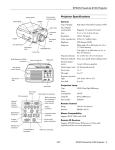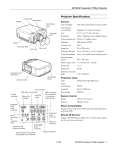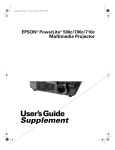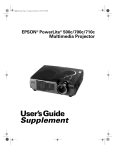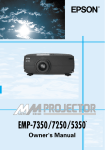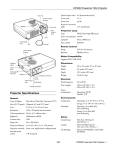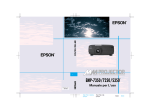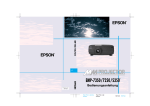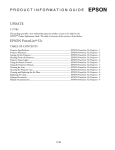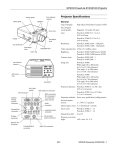Download Epson PowerLite 5350 Specifications
Transcript
EPSON PowerLite 5350/7250/7350 Projector infrared receiver Projector Specifications speaker control panel General infrared receiver status lights speaker Type of display Poly-silicon Thin Film Transistor (TFT) Size of liquid crystal panels Diagonal: 1.3 inches (33.6 mm) Lens F=2.0–2.3, f=55–72 mm Resolution PowerLite 5350: SVGA, 800 × 600 pixels PowerLite 7250/7350: XGA, 1024 × 768 pixels Color reproduction foot adjust lever handle foot adjust lever focus ring adjustable feet Brightness PowerLite 5350: 1400 lumens (ANSI) PowerLite 7250: 1200 lumens (ANSI) PowerLite 7350: 1500 lumens (ANSI) Image size Wide angle: 23 to 300 inches (at 3.9 to 40.6 feet distance) zoom ring Tele angle: 23 to 230 inches (at 5.1 to 54 feet distance) projection lens Mouse/Com 2 Repeater Computer Out rear infrared receiver Projection distance 3.18 to 54.8 feet (1.18 to 16.7 meters) Projection methods Front, rear, upside-down (ceiling mount) Internal speaker system Computer 2 Audio Out Audio 2 24 bit, 16.7 million colors Audio 1 Mouse/Com 1 1 3 × 3 W stereo output 2 × 3 W 8 (ohm) speakers Optical aspect ratio 4:3 (horizontal:vertical) Zoom ratio 1:1.3 Tilt angle 0° to 12° Supported video interface standards NTSC, PAL, PAL-M, PAL-N, SECAM Projection Lamp R/R-Y G/Y G Sync B/B-Y S-Video Computer 2/BNC switch power inlet composite video Video L-Audio-R Type UHE (Ultra High Efficiency) Power consumption 150 W Lamp life 1500 to 2000 hours (typical) Part number ELPLP09 Remote Control HD/Sync VD Computer 1 8/99 Range 32.8 feet (10 meters) Batteries Alkaline AA (2) EPSON PowerLite 5350/7250/7350 Projector - 1 EPSON PowerLite 5350/7250/7350 Projector Mouse Compatibility Mode Resolution Frequency H(KHz)/V(Hz) Dot (MHz) SVGA56 SVGA60 SVGA72 SVGA75 SVGA85 800 × 600 800 × 600 800 × 600 800 × 600 800 × 600 35.156 / 56.25 37.879 / 60.317 48.077 / 72.188 46.875 / 75 53.674 / 85.061 36 40 50 49.5 56.25 XGA43i XGA60 XGA70 XGA75 XGA85 1024 × 768 1024 × 768 1024 × 768 1024 × 768 1024 × 768 35.522 / 86.958 48.363 / 60.004 56.476 / 70.069 60.023 / 75.029 68.677 / 84.997 44.9 65 75 78.75 94.5 SXGA1_70 SXGA1_75 SXGA1_85 1152 × 864 1152 × 864 1152 × 864 63.851 / 70.012 67.5 / 75 77.094 / 84.002 94.5 108 121.5 SXGA2_60 SXGA2_75 SXGA2_85 1280 × 960 1280 × 960 1280 × 960 60 / 60 75 / 75 85.938 / 85.002 108 126 148.5 SXGA3_43i SXGA3_60 SXGA3_75 SXGA_85 1280 × 1024 1280 × 1024 1280 × 1024 1280 × 1024 46.433 / 86.871 63.981 / 60.02 79.976 / 75.025 91.146 / 85.024 78.75 108 135 157.5 UXGA48i UXGA60 UXGA65 UXGA70 UXGA75 1600 × 1200 1600 × 1200 1600 × 1200 1600 × 1200 1600 × 1200 62.5 / 96.080 75 / 60 81.25 / 65 87.5 / 70 93.75 / 75 135 162 175.5 189 202.5 MACLC13 MACII13 MAC16 MAC19-60 MAC19 MAC21 640 × 480 640 × 480 832 × 624 1024 × 768 1024 × 768 1152 × 870 34.975 / 66.62 35 / 66.67 49.725 / 74.55 48.193 / 59.28 60.241 / 74.93 68.682 / 75.062 31.33 30.24 57.28 64 80 100 HDTV480P (ANSI/SMPTE) 720 × 483 31.469 / 59.940 27 HDTV480P (ATSC) 704 × 480 31.469 / 59.940 27 HDTV480I (ANSI/SMPTE) 720 × 487 15.734 / 59.940 13.5 HDTV480I (ATSC) 704 × 480 15.734 / 59.940 13.5 HDTV720P (SMPTE) 1280 × 720 44.955 / 59.940 74.176 HDTV1080I (ANSI/SMPTE) 1920 × 1080 67.433/ 59.940 148.352 Supported Monitor Displays HDTV1080I (ANSI/SMPTE) 1920 × 1080 33.716 / 59.940 74.176 Here are the display formats supported by the projector: NTSC (SXGA) NTSC (XGA) 1366 × 438 1024 × 438 15.734 / 60 15.734 / 60 28.486 2.890 Mode Resolution Frequency H(KHz)/V(Hz) Dot (MHz) PAL (SXGA) PAL (XGA) 1366 × 512 1024 × 512 15.625 / 50 15.625 / 50 28.846 21.154 VGACGA VGAEGA 640 × 400 640 × 350 31.46 / 70 31.46 / 70 25.175 25.175 SECAM (SXGA) SECAM (XGA) 1366 × 512 1024 × 512 15.625 / 50 15.625 / 50 28.846 21.154 NEC400 640 × 400 24.83 / 56.65 21.053 VGA60 VGA72 VGA75 VGA85 640 × 480 640 × 480 640 × 480 640 × 480 31.469 / 59.94 37.861 / 72.809 37.5 / 75 48.269 / 85.008 25.175 31.5 31.5 36 Note: The frequencies of some computers may not allow the image to be displayed correctly. Supports PS/2, USB, serial, ADB Remote IR Receiver Supports EPSON remote IR receiver, 10-foot cable (typical for rear screen projection) Mechanical Height 5.1 inches (129 mm), including feet Width 11.8 inches (300 mm) Depth 15.8 inches (400 mm), including lens Weight 13.8 lb (6.2 kg) Electrical Rated frequency 50/60 Hz Power supply 100 to 120 VAC, 2.4 A 200 to 240 VAC, 1.2 A Power consumption Operating: 200 W Standby: 8.4 W Environmental Temperature Operating: 41 to 104° F (5 to 40° C), non-condensing Storage: 14 to 140° F (–10 to 60° C), non-condensing Humidity Operating: 20 to 80% RH, non-condensing Storage: 10 to 90% RH, non-condensing Safety United States FCC Part 15J Class B UL1950 Rev. 3 Canada DOC SOR/88-475 CSA C22.2 No. 950 Rev. 3 2 - EPSON PowerLite 5350/7250/7350 Projector 8/99 EPSON PowerLite 5350/7250/7350 Projector When projecting from the ceiling, align the lens as closely as possible with the top of your screen: Computer 1 and 2 and Computer Out Connector Pin Assignments The Computer 1 and 2 and Computer Out connectors are female video RGB, 15-pin micro-D-style connectors. The pin assignments are: Input pin Computer Out connector signals Computer 1 and 2 connector signals 1 Red out / red video Red video 2 Green out / green video Green video 3 Blue out / blue video Blue video 4 Reserved Monitor (ID bit 2) 5 GND GND 6 GND Red video GND 7 GND Green video GND 8 GND Blue video GND 9 Reserved +5 V 10 GND Synchronous GND 11 Reserved Monitor (ID bit 0) 12 Reserved SDA The distance between the projector and the screen determines the image size. To determine the exact distance required for a particular image size (or to determine the size of an image at a particular distance), use the following formulas for the standard, long throw, and fixed wide angle lenses. (The size of the image can also be changed by rotating the zoom ring.) 13 Horizontal sync Horizontal sync Standard Lens Calculations 14 Vertical sync Vertical sync 15 Vertical sync Reserved Calculating Image Size and Projection Distance To determine the minimum and maximum diagonal size of an image when you know the projection distance: Projector Placement Guidelines ❏ Inches: Maximum diagonal size = (0.6124 × projection distance) + 1.5264 Minimum diagonal size = (0.4556 × projection distance) + 1.1410 To get the best results when projecting your images, it is important to position the projector at the proper height and distance relative to the screen. ❏ Centimeters: Maximum diagonal size = (0.6124 × projection distance) + 3.8771 Minimum diagonal size = (0.4556 × projection distance) + 2.8981 When projecting from a table or desk, place the projector so the lens is aligned as closely as possible with the bottom of your screen: To determine the projection distance when you know the diagonal size of the screen image: ❏ Inches: Maximum projection distance = (2.1949 × diagonal size) − 2.5044 Minimum projection distance = (1.6328 × diagonal size) − 2.4923 ❏ Centimeters: Maximum projection distance = (2.1949 × diagonal size) − 6.3612 Minimum projection distance = (1.6328 × diagonal size) − 6.3304 For example, here are the measurements for three installations: Horizontal distance from projector to screen Image size (diagonal) Minimum Maximum 300 inches* (762 cm) 487.3 inches (12.4 m) 656.0 inches (16.7 m) 200 inches (508 cm) 324.1 inches (8.2 m) 436.5 inches (11.1 m) 100 inches (254 cm) 160.8 inches (4.1 m) 217.1 inches (5.5 m) * For an image size of 300 inches, the projector may be up to 54 feet away from the screen, depending on the setting of the zoom ring. 8/99 EPSON PowerLite 5350/7250/7350 Projector - 3 EPSON PowerLite 5350/7250/7350 Projector Long Throw Zoom Lens Calculations Projector Status Lights If you are using the optional long throw zoom lens, use the following formulas. The status lights on top of the projector tell you the projector’s operating status. To determine the minimum and maximum diagonal size of an image when you know the projection distance: ❏ Inches: Maximum diagonal size = (0.4742 × projection distance) + 3.2489 Minimum diagonal size = (0.2849 × projection distance) + 1.8968 projection lamp light power light temperature light ❏ Centimeters: Maximum diagonal size = (1.2045 × projection distance) + 8.2521 Minimum diagonal size = (0.7236 × projection distance) + 4.8179 To determine the projection distance when you know the diagonal size of the screen image: ❏ Inches: Maximum projection distance = (3.5094 × diagonal size) − 6.6568 Minimum projection distance = (2.1090 × diagonal size) − 6.8519 ❏ Centimeters: Maximum projection distance = (8.9139 × diagonal size) − 16.9083 Minimum projection distance = (5.3569 × diagonal size) − 17.4038 Caution: A red light warns you if a serious problem occurs. Power Light Fixed Wide Angle Lens Calculations If you are using the optional fixed wide angle lens, use the following formulas. To determine the minimum and maximum diagonal size of an image when you know the projection distance: ❏ Inches: Maximum diagonal size = (0.730 × projection distance) + 3.919 Minimum diagonal size = (0.616 × projection distance) + 3.050 ❏ Centimeters: Maximum diagonal size = (1.8542 × projection distance) + 9.9542 Minimum diagonal size = (1.5646 × projection distance) + 7.7470 Light status Meaning Steady orange Sleep mode. (The projector is plugged in, but not projecting.) Steady green Power and lamp are on. Flashing green The projector is warming up. Allow about 30 seconds. Flashing orange The projector is cooling down. Off The power cord is not plugged in, there is no power to the electrical outlet, or there is an internal projector problem. Projection Lamp Light To determine the projection distance when you know the diagonal size of the screen image: ❏ Inches: Maximum projection distance = (1.619 × diagonal size) - 4.702 Minimum projection distance = (1.367 × diagonal size) - 5.640 ❏ Centimeters: Maximum projection distance = (4.1122 × diagonal size) - 11.9430 Minimum projection distance = (3.4721 × diagonal size) - 14.3256 Light status Meaning Orange and red flashing alternately Projection lamp needs replacing. Steady red Projection lamp has burned out. Replace lamp. Flashing red Problem with projection lamp or lamp power supply. Off Lamp is functioning normally. Temperature Light Light status 4 - EPSON PowerLite 5350/7250/7350 Projector 8/99 Meaning Flashing orange Projector is too hot. Steady red Projector has turned off automatically because of overheating. Flashing red Problem with the cooling fan or temperature sensor, causing overheating. Off The projector is functioning normally. EPSON PowerLite 5350/7250/7350 Projector Open the cover just below the Esc button to access additional remote control commands. Using the Remote Control The remote control uses a line-of-sight infrared signal. To use the remote control, point it towards one of the infrared receivers located at the front and back of the projector. You can use the remote control up to about 32.8 feet (10 meters) from the projector. (This distance may be shorter if the remote control batteries are low.) You must also be within a ± 30° angle from the front or rear receiver. Power Freeze A/V Mute R/C ON OFF E-Zoom 3 4 2 1 5 Note: The projector may not respond to remote control commands in these conditions: ambient light is too bright; a certain type of fluorescent light is present; a strong light source (such as direct sunlight) shines into the infrared receiver; or other equipment emitting infrared energy is present (such as a radiant room heater). Correct these conditions to use the remote control or control the projector from a computer. Enter Menu Esc Help Menu Help Comp1 BNC Comp1 S-Video BNC S-Video Video Auto Resize P in P Preset Auto Front P in P E-Zoom Power Power A/V Mute R/C ON OFF E-Zoom 3 5 1 2 Volume remote control On/Off 4 illumination Preset Freeze Special effects buttons (1-5) Enter (pointer) button Resize IR output Freeze A/V Mute - Volume + Video Enter Esc Esc button Back battery cover cover lock 8/99 EPSON PowerLite 5350/7250/7350 Projector - 5 EPSON PowerLite 5350/7250/7350 Projector This table summarizes the functions on the remote control. Power Starts or stops the projector. Freeze Keeps the current computer or video image on the screen. A/V Mute Turns off the audio and video, displaying either the black, blue or user logo background. E-Zoom Enlarges or reduces the image size from 1x to 4x. Pressing the right side of the button enlarges the image, pressing the left side of the button reduces the image. To display a portion of an enlarged image which is outside the display area, press the Enter button and scroll the image to the desired location. RC On/Off Turns the remote control on or off. Effects buttons Use to display preprogrammed special effects. Effects can be modified using the ELP Link IV software, or control panel menu options. Enter (pointer button) Use the Enter button to navigate the menus or use the remote as a mouse pointer when the projector is connected to the computer with the main cable and the mouse cable. When the image source is Computer, the Enter button acts as a mouse left-click. Illumination Illuminates all buttons on the remote control for 10 seconds. Esc Stops the current function. Pressing Esc while viewing a menu or the online help displays the previous screen or menu. When the image source is Computer, the Esc button acts as a mouse right-click. Menu Displays or hides the menu. Comp1 Switches to the Computer 1 image. S-Video Switches to the S-Video image. Auto Optimizes the computer image. P in P Displays a video or S-video image in a subscreen on the main display. Use the Enter button to reposition the Picture in Picture (P in P) screen, or the E-Zoom button to enlarge or reduce the image. Changes made to the P in P screen location and size are automatically carried over to the next P in P session. Help Displays the online help menu. BNC Switches to the Computer2/BNC image. Video Switches to the Video image. Resize Switches the display dot mode and resize mode for VGA, XGA, SVGA, and SXGA input. You cannot resize the image if the input resolution matches the output resolution of the projector (SVGA for the PowerLite 5350, or XGA for the PowerLite 7250 and 7350). Preset – Volume + Power Computer A/Vmute Resize Video Sync Sync Keystone Shift Volume You can use the control panel to control the projector instead of the remote control. However, you can program and access the custom features only with the remote control. The following table summarizes the functions on the control panel. Saves and recalls up to five different session settings (resolution, tracking, sync signal and position). To save the current session settings, press the Preset button and it will be assigned the next available number, 1 through 5. To recall a setting, press the Preset button a second time and move to the desired session number. To overwrite a saved setting, move to the setting you want to replace and press Enter. When the confirmation message displays, choose Yes and press Enter. Adjusts the volume. 6 - EPSON PowerLite 5350/7250/7350 Projector Help Esc Menu Tracking Function Tracking Button Using the Control Panel 8/99 Button Function Power Starts or stops projection. Help Displays the online help menu. Computer Switches between Computer 1 and Computer 2. (When the Computer 2/BNC switch on the back of the projector is set to BNC, the source is switched to 5BNC.) A/V Mute Turns off the audio and video, displaying the black, blue, or user logo background. Resize Switches the display dot mode and resize mode for VGA, XGA, SVGA, and SXGA input. You cannot resize the image if the input resolution matches the output resolution of the projector (SVGA for the PowerLite 5350, or XGA for the PowerLite 7250 and 7350). Video Switches to the video image. Pressing the button once switches to composite video, pressing it twice switches to S-Video. Menu Displays or hides the menu. Esc Stops the current function. Pressing Esc while viewing a menu or the online help displays the previous screen or menu. When the image source is Computer, the Esc button acts as a mouse right-click. Up, down arrows (Sync+/Sync-) Synchronizes the computer’s graphic signal. Use these buttons to adjust an overall image that is fuzzy or streaked, or to select menu items during menu operations. Allows movement or selection of a menu, if a menu is displayed. Left, right arrows (tracking-/ tracking+) Matches the projector’s internal clock to various computer graphic signals (tracking adjustment). Use these buttons to adjust an image with vertical fuzzy lines, or to change numeric settings during menu operations. Allows movement of a menu, if a menu is displayed. EPSON PowerLite 5350/7250/7350 Projector Replacing the Lamp Button Function Enter Selects a menu option or the next menu/help screen. Pressing Enter when no menu or help screen is displayed optimizes the computer image. Shift The projection lamp typically lasts for about 1500 to 2000 hours of use. It is time to replace the lamp when: Pressing the shift and Keystone buttons at the same time increases or decreases the sound volume. – Keystone + Adjusts a trapezoid distorted image to normal. – Volume + Adjusts the volume when used in conjunction with the Shift button. ❏ The projected image gets darker or starts to deteriorate. ❏ The projection lamp indicator is either red, or flashing orange and red alternately. ❏ The message LAMP REPLACE appears on the screen when the projection lamp comes on. Warning: Let the lamp cool before replacing it. Also, do not touch the glass portion of the lamp assembly. Touching the glass portion of the lamp will result in premature lamp failure. Cleaning the Air Filter Clean the air filter at the bottom of the projector after every 100 hours of use. If it is not cleaned periodically, it can become clogged with dust, preventing proper ventilation. This can cause overheating and damage the projector. To clean the air filter, follow these steps: 1. Turn off the projector and unplug the power cable. 2. Turn the projector over so you can access the lamp cover. 3. Use a screwdriver, coin, or similar object to loosen the two retaining screws on the lamp cover. When the screws are loose, lift off the lamp cover. (You cannot remove these screws from the cover.) 1. Turn off the projector and unplug the power cable. 2. Turn the projector on its side so that the handle is on top and you can access the filter easily. Note: Standing the projector with the handle at the top keeps dust from getting inside the projector housing. 3. Pull the filter cover tab to release the filter cover. Remove the cover. 2 2 1 4. Use a screwdriver, coin, or similar object to loosen the two screws holding the lamp unit in position. (You cannot remove these screws completely.) 1 4. The filter is attached to the inside of the filter cover. It is recommended that you use a small vacuum cleaner designed for computers and other office equipment to clean the filter. If you don’t have one, use a dry, lint-free cloth. If the dirt is difficult to remove or the filter is torn, replace it. 5. Replace the filter cover when you’re done. 2 1 5. Lift up the handle and pull out the lamp unit. 8/99 EPSON PowerLite 5350/7250/7350 Projector - 7 EPSON PowerLite 5350/7250/7350 Projector 6. Gently insert the new lamp unit by lowering it into position. Make sure it’s inserted securely. Tighten the screws on the new lamp unit. 7. Replace the lamp cover and tighten the cover screws. (Make sure the lamp cover is securely fastened. The projector turns itself off if the lamp cover is open.) Information Reference List Engineering Change Notices None. Technical Information Bulletins None. Product Support Bulletins None. Related Documentation CPD 8871 EPSON PowerLite 5350/7250/7350 User’s Guide CPD 8872 EPSON PowerLite 5350/7250/7350 Portable Guide SM-ELP5350/7X50 EPSON PowerLite 5350/7250/7350 Multimedia Projector Service Manual PL-ELP5350 EPSON PowerLite 5350 Multimedia Projector Parts Price List PL-ELP7250 EPSON PowerLite 7250 Multimedia Projector Parts Price List PL-ELP7350 EPSON PowerLite 7350 Multimedia Projector Parts Price List 8 - EPSON PowerLite 5350/7250/7350 Projector 8/99








